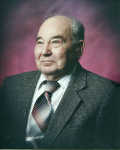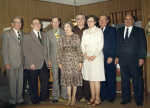Death signals end of an era

For more than 60 years, the Maxwell name was synonymous with the Nevada business community and remembered by many for years after they sold their last business and retired.
That era came to an end on Feb. 19. when Ray Maxwell, the youngest of the six Maxwell boys who ran the two grocery stores, died at the age of 96.
Everyone in Nevada knew Ray Maxwell as "Doc" Maxwell, but very few people knew how he got that nickname, said Ray Forrest Maxwell, Ray's son, who lives in Vancouver, Canada.

Ray Forrest Maxwell was named after his father Ray and his uncle Forrest, the oldest of the six brothers.
"When he was a young school boy, he took some "candy" from the store to school and handed it out to all his friends at school, Ray Forrest said. "In fact, the 'candy' was Exlax. Everyone really enjoyed the chocolate 'candy.' However, later the teacher was kept busy giving out hall passes so that my Dad's friends could make a run to the outhouse behind the school.
For the rest of his life he was called 'Doc' Maxwell," Ray Forrest said.
Ray Maxwell was born in Nevada in 1916, nine years after his father, Tom, and mother, Eva, loaded their two boys, Forrest and Orville and their few belongings into a wagon to move to Nevada from Sheldon for a job on the railroad.
According to a story written by Betty Sterett for the Nevada Herald and later included in a compilation of her writing, "Scenes from the Past," the Maxwells settled into a small four-room house at the corner of Atlantic and Washington streets, on the north edge of town. There they stayed for 20 years and grew their family to include four more boys and two girls.
When the opportunity arose, Tom purchased a cider and grist mill on West Walnut Street when the owner moved to Montana, thus starting the family business. Maxwell hired P.V. Hereford, the grandfather of longtime Vernon County Judge Hereford Kelso, to operate the mill.
When the city decided to pave West Walnut Street, Maxwell tore down the mill and purchased six lots in the neighborhood of his house and moved the mill to the corner of Atlantic and Cedar streets.
With all that property, the Maxwells started a strawberry patch and sold the berries in the spring.
In 1917, the Maxwells took their first step into the grocery business when a grocery store on north Main was moved to the Square.
After a family discussion, the Maxwells added a few canned goods other staples to the mill and before long they had a thriving grocery business and added a room for the groceries.
The Maxwell boys worked in the businesses after school and when oldest son, Forrest, graduated from high school, he took over operating the grocery business, while his father continued to operate the mill.
When a meat department was added in 1921, Orville talked his father into letting him drop out of school to run it.
Over time, horse drawn wagons were replaced with modern trucks to make grocery deliveries.
The store opened at 6 a.m. and closed when the last customer left, after which the boys spent hours sacking sugar, flour, beans and other staples that only came in bulk in those days.
Most customers would call in an order by telephone and pay their bill on the first of the month.
In 1926, Ray's parents built the large white house that still stands on the southwest corner of Atlantic and Cedar streets. According to Sterett's article, it was the first house in Nevada built with pre-cut lumber.
Like the other boys, Ray worked in the family business until World War II came along.
According to Ray Forrest, his father enlisted in the Army Air Corps on Dec. 8, 1941, the day after the Japanese attacked Pearl Harbor
"He trained as a B-17 flight engineer and gunner. A few days before his crew was to ship out to Europe, he came down sick with scarlet fever," Ray Forrest said. "They put him in quarantine in the hospital and put another flight engineer in his place and his crew shipped out without him.
"He found out in a few weeks that his crew was shot down on one of their early missions. Half of the crew was killed and the other half spent the rest of the war in a German prison camp."
"If you were sent to Europe you had to fly 25 missions to finish your tour of duty. You had a 50-50 chance of making it in the early part of the war. It got better later in the war due to better fighter escorts," his son said.
"My father was sent back to Nevada after he got out of the hospital for a few weeks of recovery and rest" Ray Forrest continued. "Before he went into the Army Air Corps, he had been dating my mother. While he was in Nevada for rest and recovery, he married my mother. She then followed him from base to base as he was re-assigned to work on the ground and train other flight engineers.
"In 1943, he was re-trained on a B-24 as a flight engineer and gunner and sent to the South Pacific. In the South Pacific you were required to fly 50 missions to complete your tour of duty. You had a much better chance of completing your tour due to the fact that the war was spread out over a much larger area and the targets were not as heavily protected," Ray Forest said.
"Most of the time, my father told me they only were attacked by fighters and ground ack-ack over the target.
"The flights in the Pacific were much longer than in Europe. He flew one mission to Formosa (Taiwan ... it was Japanese territory at the time) that lasted 12 hours. They took off at 6 a.m. and were over the target by noon. They returned to base at 6 p.m. that evening. I am not sure why, but he did 55 missions over Japanese territory before returning to the U.S.," Ray Forest said.
During Ray's time in the Air Corps, he earned the Air Medal with four Oak Leaf clusters and learned how to build and repair different types of equipment.
"If he shipped out with the first B-17 crew, I might not be here," Ray Forrest said.
In 1954, the Maxwells opened their Highway Market on the southeast corner of Hickory and Osage, with Cecil as the manager, Frank running the produce department and Ray in the butcher shop. It was the first self-service supermarket in Nevada with the first automatic doors and open refrigerated shelves.
In the early 1960s, Ray Forest got interested in ham radio and shortly afterwards, Ray got his own ham license and filled his spare time talking to fellow hams around Missouri and the United States, and later used it to talk to his son when he moved to Vancouver.
In later years, arthritis slowed Ray down, but he still made use of modern technology to keep in touch with his son, who installed a remotely controlled computer and Skype so they could easily keep in touch.
Ray Forrest said he tried to get his father to move to the Vancouver area to be closer, but Nevada was Ray's home and that was where he wanted to spend the remainder of his life.
